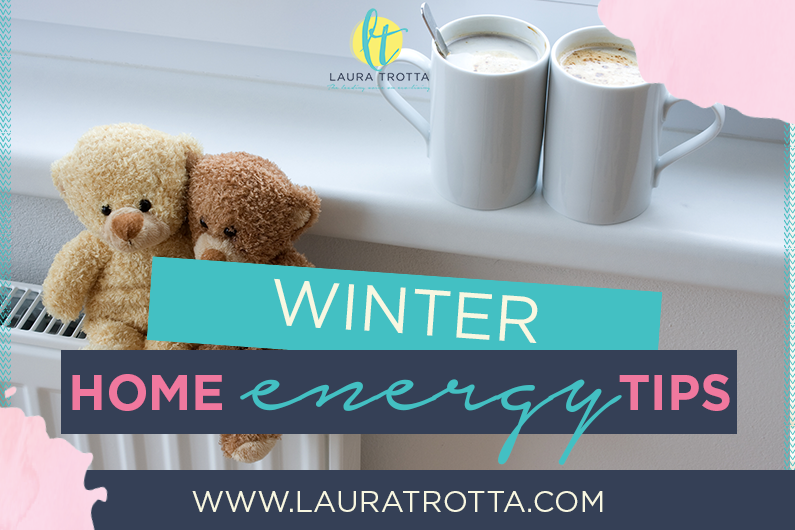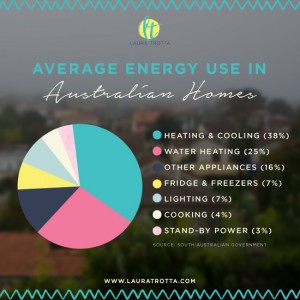Are you keen to reduce your home energy consumption (and power bills) this winter but don’t know where to start?
In this post I’ll share some home energy tips to help you reduce your household’s energy consumption throughout the cooler months, without compromising your lifestyle.
Podcast: Play in New Window
Before you jump into action-taking mode, it pays to understand where you’re actually using energy in your home so you can prioritize the areas where you’ll get a bigger bang for your buck, so to speak.
In an average Australian home, heating and cooling our living space makes up just under 40% of household energy use. Water heating is second in line, typically accounting for 25% of your energy bills. This is the cost associated with ensuring you have hot water ready to go when you have a shower, clean your dishes or wash your clothes (if you use warm water for your laundry).
So with just under 65% of an average Australian households energy consumption used for heating and cooling the home and heating hot water, these areas are a good place to focus on for some serious energy savings.
HOME HEATING ENERGY SAVING TIPS
In winter, the main aim is to keep warm air inside and cool air outside your home. By effectively maintaining the temperature within your home, you’re less likely to need to turn your heater on or can run it for shorter periods.
When it comes to heating your home, it’s recommended to set your thermostat to 18-20°C in winter. Every degree warmer will add an additional 10% to the energy use, and running costs, of the appliance!
Dressing for the weather is a common sense approach to home heating. After all, putting a jumper on is much better than turning your heater up.
Likewise, learn to practice ‘zoning’ and heat only the rooms that are occupied, closing the doors to rooms used infrequently. It really makes no sense to heat your laundry if you’re only in there for 10 minutes a day! If you spend most of your time in the living room, perhaps it would be smarter to invest in a small energy efficient heater for that room rather than using central heating which heats the rest of the house or make use of zoned central heating if it is available.
Being energy efficient when it comes to heating our homes is as much about keeping warm air inside our homes than it is by using heater to warm the air.
Three ways we can prevent heat loss from our homes are:
1. Cover Your Windows
If you’ve ever been seated next to the window in a restaurant in winter, you’ll know it’s the coldest seat in the house (unless you’re right at the doorway!)
It’s the same in our homes.
Single-glazed windows have minimal insulative properties, so when uncovered they allow cool air in and heat out (in fact 15 times more than an insulated wall), therefore making your heater work harder. Ideally, double glazing provides the most efficient way to minimise heat loss through windows, however, this is not always practical or affordable.
Curtains and pelmets have an important insulating role to play in winter. A pelmet above the curtain stops airflow between the window and curtain. Without one, you’ll feel a very cold draught at the base of the curtain. This draught is the result of warm air going over the top of the curtain, hitting the cold window, and flowing out the base as cold air.
Close-fitting curtains with pelmets can be as effective as double-glazed windows at reducing heat loss.
Of course, if you live in the southern hemisphere, open north facing curtains during the daytime in winter to capture the sun’s warmth and close all curtains as it gets cooler and darker in the late afternoon. This will stop heat escaping from exposed windows.
2. Install Insulation
When we use so much energy (and money) to heat our homes, it only makes sense that we want to keep as much of it in as possible.
Enter insulation.
Insulation really is the most important factor in reducing your home energy use.
Generally, the easiest and most accessible area to install insulation is in your roof cavity. If you are doing renovations, also consider putting insulation in the walls and under the floor.
3. Seal Draughts In Your Home
It might sound obvious but heat enters and escapes our home through our roofs especially if they aren’t insulated. Also through our windows, walls, floors and cracks and gaps. Draught-proofing can be as simple as using a door snake to seal a gap between a door and the floor or using an adhesive draught stopper to seal around a window. Filling gaps in floorboards may require a bit of work, so if this isn’t possible, you could buy a new rug or carpet off-cut to reduce draughts coming up under the floor.
HOT WATER SERVICE ENERGY SAVING TIPS
Many homes these days have solar hot water services, but even these have a booster which kicks in when the water isn’t warm enough. In cooler months this may be most of the time.
Those without solar, or instantaneous hot water, are paying for a system to continuously keep a large volume of hot water at a specific temperature.
Think of those large hot water urns when you go to conferences and workshops. Every now and then you’ll hear them kick in and heat up the water again. Well, that’s what your hot water service is like. And having hot water on tap is not cheap.
Regardless of the type of hot water service you have installed, the following tips will help you reduce your energy consumption from heating water.
1. Check The Temperature Of Your Hot Water
Many homes with storage water heaters have their thermostats set too high. For safety reasons, your thermostat should be set to a minimum of 60°C to prevent growth of harmful Legionella bacteria. Any temperature higher than this means that energy is used unnecessarily.
To check the temperature at your unit, drain water directly from your storage unit over an industrial thermometer (taking care not to burn yourself). If your thermostat is over 65°C, lower it to 60°C.
If you’re unable to tap water off directly at your unit, run the hot water tap inside your home that’s closest to your hot water service over your thermometer. You want to aim for a temperature here of 50°C. If it’s significantly warmer than 50°C, lower the thermostat of your unit.
2. Reduce Heat Loss From Your Pipes
Much heat can be lost from the hot and cold pipes attached to your hot water service. The amount of heat lost can be significantly reduced by insulating these pipes with lagging.
For a small price, you can purchase lagging from your local hardware store. Lagging is basically a foam tubing. To use, cut along the length so you can easily feed the lagging around the pipe. Secure with tape if required.
3. Maintain Your Hot Water Service
Again, it may seem obvious, but most people don’t really consider looking after their hot water service until the day when it breaks down.
If pays to regularly check that there are no drips from your unit, including from the relief valve from your heater. As a rule of thumb, if you place a bucket under the relief valve and it fills in a day, your valve needs replacing.
If your hot water service is due for replacement, consider installing a solar unit with instantaneous gas booster, or a 5-star gas or heat pump hot water system.
Maintaining your hot water service and ensuring the settings on the system are optimized is only half the piece of pie when reducing energy consumption associated with water heating. The other half relates to reducing the amount of hot water you actually use! You’ll find plenty of tips on this topic, that help you save even more cash, in greenHOUSE Home Energy Blitz.
So there you have it! Some home energy tips to help you get started in reducing your home energy consumption over the cooler months this year.
If you’re really keen to learn tips on how you can make your home more energy efficient check out my FREE 5 Day Home Energy Challenge.
If you’re ready to step up even further and fully maximise the savings that come by reducing your home energy consumption, check out greenHOUSE Home Energy Blitz. This program is delivered by 21 bite-sized emails, where much like if you had a home energy auditor beside you, I share all the tips, tricks and little tweaks you need to make around your home to help you save heaps of energy and money!
Podcast: Play in new window | Download
- Sustainable Home Design- factors to consider to maximise sustainability - July 28, 2022
- Advantage and Disadvantages of Tiny Houses - May 31, 2022
- How School Strike 4 Climate is Empowering Youth to Fight for Their Future - May 1, 2022




 Laura Trotta is one of Australia’s leading home sustainability experts. She has a Bachelor of Environmental Engineering, a Masters of Science (in Environmental Chemistry) and spent 11 years working as an environmental professional before creating her first online eco business, Sustainababy, in 2009. She has won numerous regional and national awards for her fresh and inspiring take on living an ‘ecoceptional’ life (including most recently winning the Brand South Australia Flinders University Education Award (2015) for the north-west region in SA and silver in the Eco-friendly category of the 2015 Ausmumpreneur Awards). With a regular segment on ABC Radio and with her work featured in publications like Nurture Parenting and My Child Magazine, Laura is an eco thought leader who’s not afraid to challenge the status quo. A passionate believer in addressing the small things to achieve big change, and protecting the planet in practical ways, Laura lives with her husband and two sons in outback South Australia.
Laura Trotta is one of Australia’s leading home sustainability experts. She has a Bachelor of Environmental Engineering, a Masters of Science (in Environmental Chemistry) and spent 11 years working as an environmental professional before creating her first online eco business, Sustainababy, in 2009. She has won numerous regional and national awards for her fresh and inspiring take on living an ‘ecoceptional’ life (including most recently winning the Brand South Australia Flinders University Education Award (2015) for the north-west region in SA and silver in the Eco-friendly category of the 2015 Ausmumpreneur Awards). With a regular segment on ABC Radio and with her work featured in publications like Nurture Parenting and My Child Magazine, Laura is an eco thought leader who’s not afraid to challenge the status quo. A passionate believer in addressing the small things to achieve big change, and protecting the planet in practical ways, Laura lives with her husband and two sons in outback South Australia. 


